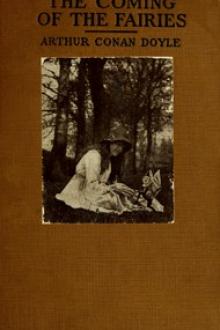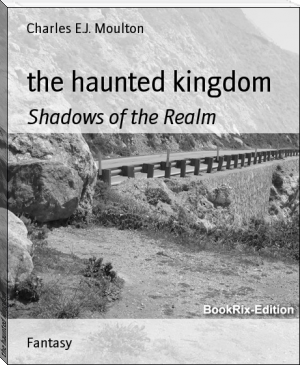The Coming of the Fairies, Arthur Conan Doyle [motivational novels .TXT] 📗

- Author: Arthur Conan Doyle
- Performer: -
Book online «The Coming of the Fairies, Arthur Conan Doyle [motivational novels .TXT] 📗». Author Arthur Conan Doyle
Some three years before, according to our information, the daughter and the niece of Mr. Carpenter, the former being sixteen and the other ten years of age, had taken the two photographs—the one in summer, the other in early autumn. The father was quite agnostic in the matter, but as his daughter claimed that she and her cousin when they were together continually saw fairies in the wood and had come to be on familiar and friendly terms with them, he entrusted her with one plate in his camera. The result was the picture of the dancing elves, which considerably amazed the father when he developed the film that evening. The little girl looking across at her playmate, to intimate that the time had come to press the button, is Alice, the niece, while the older girl, who was taken some months later with the quaint gnome, is Iris, the daughter. The story ran that the girls were so excited in the evening that one pressed her way into the small dark-room in which the father was about to develop, and that as she saw the forms of the fairies showing through the solution she cried out to the other girl, who was palpitating outside the door: "Oh, Alice, Alice, the fairies are on the plate—they are on the plate!" It was indeed a triumph for the children, who had been smiled at, as so many children are smiled at by an incredulous world for stating what their own senses have actually recorded.
The father holds a position of trust in connection with some local factory, and the family are well-known and respected. That they are cultivated is shown by the fact that Mr. Gardner's advances towards them were made more easy because Mrs. Carpenter was a reader of theosophical teachings and had gained spiritual good from them. A correspondence had arisen and all their letters were frank and honest, professing some amazement at the stir which the affair seemed likely to produce.
Thus the matter stood after my meeting with Mr. Gardner, but it was clear that this was not enough. We must get closer to the facts. The negatives were taken round to Kodak, Ltd., where two experts were unable to find any flaw, but refused to testify to the genuineness of them, in view of some possible trap. An amateur photographer of experience refused to accept them on the ground of the elaborate and Parisian coiffure of the little ladies. Another photographic company, which it would be cruel to name, declared that the background consisted of theatrical properties, and that therefore the picture was a worthless fake. I leaned heavily upon Mr. Snelling's whole-hearted endorsement, quoted later in this article, and also consoled myself by the broad view that if the local conditions were as reported, which we proposed to test, then it was surely impossible that a little village with an amateur photographer could have the plant and the skill to turn out a fake which could not be detected by the best experts in London.
The matter being in this state, Mr. Gardner volunteered to go up at once and report—an expedition which I should have wished to share had it not been for the pressure of work before my approaching departure for Australia. Mr. Gardner's report is here appended:
5 Craven Road, Harlesden, N.W.10, July 29, 1920.
It was early in this year, 1920, that I heard from a friend of photographs of fairies having been successfully taken in the North of England. I made some inquiries, and these led to prints being sent to me with the names and address of the children who were said to have taken them. The correspondence that followed seemed so innocent and promising that I begged the loan of the actual negatives—and two quarter-plates came by post a few days after. One was a fairly clear one, the other much under-exposed.
The negatives proved to be truly astonishing photographs indeed, for there was no sign of double exposure nor anything other than ordinary straightforward work. I cycled over to Harrow to consult an expert photographer of thirty years' practical experience whom I knew I could trust for a sound opinion. Without any explanation I passed the plates over and asked what he thought of them. After examining the "fairies" negative carefully, exclamations began: "This is the most extraordinary thing I've ever seen!" "Single exposure!" "Figures have moved!" "Why, it's a genuine photograph! Wherever did it come from?"
I need hardly add that enlargements were made and subjected to searching examination—without any modification of opinion. The immediate upshot was that a "positive" was taken from each negative, that the originals might be preserved carefully untouched, and then new negatives were prepared and intensified to serve as better printing mediums. The originals are just as received and in my keeping now. Some good prints and lantern slides were soon prepared.
In May I used the slides, with others, to illustrate a lecture given in the Mortimer Hall, London, and this aroused considerable interest, largely because of these pictures and their story. A week or so later I received a letter from Sir A. Conan Doyle asking for information concerning them, some report, I understood, having reached him from a mutual friend. A meeting with Sir Arthur followed, and the outcome was that I agreed to hasten my proposed personal investigation into the origin of the photographs, and carry this through at once instead of waiting till September, when I should be in the North on other matters.
In consequence, to-day, July 29, I am just back in London from one of the most interesting and surprising excursions that it has ever been my fortune to make!
We had time, before I went, to obtain opinions on the original negatives from other expert photographers, and one or two of these were adverse rather than favourable. Not that any would say positively that the photographs were faked, but two did claim that they could produce the same class of negative by studio work involving painted models, etc., and it was suggested further that the little girl in the first picture was standing behind a table heaped up with fern and moss, that the toad-stool was unnatural, that in the gnome photo the girl's hand was not her own, that uniform shading was questionable, and so on. All of this had its weight, and though I went North with as little bias one way or the other as possible, I felt quite prepared to find that a personal investigation would disclose some evidence of falsity.
A. FRANCES AND THE FAIRIES
Photograph taken by Elsie. Bright sunny day in July, 1917. The "Midg" camera. Distance, 4 ft. Time, 1/50th sec. The original negative is asserted by expert photographers to bear not the slightest trace of combination work, retouching, or anything whatever to mark it as other than a perfectly straight single-exposure photograph, taken in the open air under natural conditions. The negative is sufficiently, indeed somewhat over-exposed. The waterfall and rocks are about 20 ft. behind Frances, who is standing against the bank of the beck. A fifth fairy may be seen between and behind the two on the right. The colouring of the fairies is described by the girls as being of very pale pink, green, lavender, and mauve, most marked in the wings and fading to almost pure white in the limbs and drapery. Each fairy has its own special colour.
The lengthy journey completed, I reached a quaint, old-world village in Yorkshire, found the house, and was cordially received. Mrs. C. and her daughter I. (the girl as shown playing with the gnome) were both at home to meet me, and Mr. C., the father, came in shortly afterwards.
Several of the objections raised by the professionals were disposed of almost at once, as, a half-hour after reaching the house, I was exploring a charming little valley, directly at the rear, with a stream of water running through, where the children had been accustomed to see and play with the fairies. I found the bank behind which the child, with her shoes and stockings off, is shown as standing; toad-stools exactly as in the photograph were about in plenty, quite as big and hearty-looking. And the girl's hand? Well, she laughingly made me promise not to say much about it, it is so very long! I stood on the spots shown and easily identified every feature. Then, in course of eliciting all that one could learn about the affair, I gathered the following, which, for the sake of conciseness, I set out below:
Camera used: "The Midg" quarter-plate. Plates: Imperial Rapid.
Fairies photo: July 1917. Day brilliantly hot and sunny. About 3 p.m. Distance: 4 feet. Time: 1-50th second.
Gnome photo: September 1917. Day bright, but not as above. About 4 o'clock. Distance: 8 feet. Time: 1-50th second.
I. was sixteen years old; her cousin A. was ten years. Other photographs were attempted but proved partial failures, and plates were not kept.
Colouring: The palest of green, pink, mauve. Much more in the wings than in the bodies, which are very pale to white. The gnome is described as seeming to be in black tights, reddish-brown jersey, and red pointed cap. He was swinging his pipes, holding them in his left hand and was just stepping up on to I.'s knee when A. snapped him.
A., the visiting cousin, went away soon after, and I. says they must be together to "take photographs." Fortunately they will meet in a few weeks' time, and they promise me to try to get some more. I. added she would very much like to send me one of a fairy flying.
Mr. C.'s testimony was clear and decisive. His daughter had pleaded to be allowed to use the camera. At first he demurred, but ultimately, after dinner one Saturday, he put just one plate in the Midg and gave it to the girls. They returned in less than an hour and begged him to develop the plate as I. had "taken a photograph." He did so, with, to him, the bewildering result shown in the print of the fairies!
Mrs. C. says she remembers quite well that the girls were only away from the house a short time before they brought the camera back.
Extraordinary and amazing as these photographs may appear, I am now quite convinced of their entire genuineness, as indeed would everyone else be who had the same evidence of transparent honesty and simplicity that I had. I am adding nothing by way of explanations or theories of my own, though the need for two people, preferably children, is fairly





Comments (0)